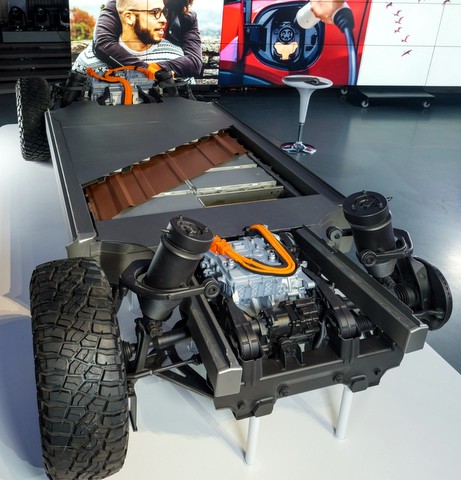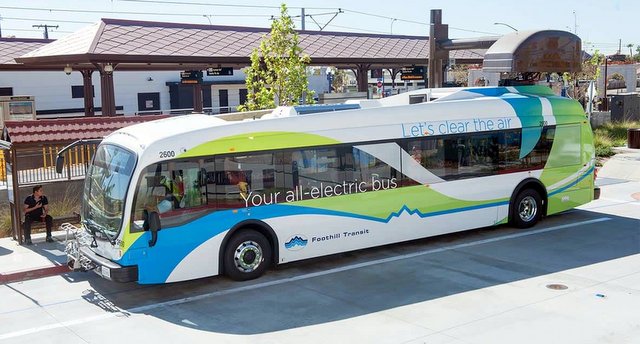What the EV Future Looks Like Under the New Administration
The Green New Deal has received a lot of attention since it was introduced in the U.S. House of Representatives in early 2019. But how many people have actually read it and know what’s in it?
The bill isn’t long, as bills go, but it’s dense. I’ve tried to pull out the main points below. You can read the complete text of the bill here.
President-elect Joe Biden has a lengthy description of his ambitious climate plan on his website. It’s based on the Green New Deal and contains many specific proposals. I walk you through it below.
In the interests of space and clarity, I am using an outline format with bullet points in some parts of this post.
The Green New Deal
The Green New Deal, H.RES.109, is not a law—It’s a framework for dealing with the climate crisis while also boosting job creation and addressing systemic racism and discrimination. It was named in the spirit of President Roosevelt’s New Deal, which helped pull America out of the Great Depression in the 1930s. It also is meant to reflect the efforts and sacrifices that the United States made during World War II.

On February 7, 2019, Representative Alexandria Ocasio-Cortez, the bill’s sponsor, introduced the Green New Deal in the U.S. House of Representatives of the 116th Congress, 1st Session, along with 68 other cosigners.
To back up its climate change proposals, the bill references the October 2018 Special Report on Global Warming of 1.5 degrees by the UN’s Intergovernmental Panel on Climate Change and the November 2018 Fourth National Climate Assessment Report.
The reasons given for presenting the bill were:
- Human activity is the dominant cause of climate change.
- Climate change leads to many catastrophic results, including sea level rise, wildfires, storms, droughts.
- Global warming more than two degrees Celsius will create even greater issues, such as mass migrations, lost economic output, destruction of coral reefs and damage to infrastructure.
The stated climate goal is to keep global temperature rise below 1.5 degrees C. This means reducing greenhouse gases by 40 to 60 percent by 2030 with the longer-term goal of net zero global emissions by 2050. These numbers reflect the latest scientific consensus and commitments now being made by large corporations and other nations, as built into the Paris Climate Accord of 2015. The United States is officially out of the Paris Agreement as of November 4, 2020, but will presumably re-enter it next year under a Biden presidency.
The actions described in the Green New Deal would commit the United States, a major emitter, to taking a leading role in fighting climate change. It lays out a 10-year plan to achieve net-zero greenhouse gas emissions through a “fair and just†transition, creating millions of good new jobs building a sustainable infrastructure and industries, as well as securing clean air and water, climate resiliency, healthy food, access to nature and a sustainable environment.
The Green New Deal also promotes justice and equity for people of color, indigenous communities, migrant communities, deindustrialized communities, depopulated rural communities, the poor, low-income communities, women, the elderly, the unhoused, disabled and youth.
Climate Action Goals
The bill contains a long menu of goals and tasks, but the main ones for climate action include:
- Building climate change resiliency against disasters
- Repairing U.S infrastructure
- Moving to 100 percent clean, renewable, zero-emission power, including smart power grids
- Upgrading existing buildings
- Growing clean manufacturing
- Working with farmers and ranchers to remove pollution and greenhouse gases
- Overhauling transportation systems to remove pollution and greenhouse gases
- Mitigating and managing the effects of climate change
- Removing greenhouse gases from the atmosphere and restoring natural ecosystems
- Cleaning up hazardous waste
- Sharing technology, products, and services with other countries
- Protecting public lands, water and oceans
Economic and Social Goals
The economic and social goals include:

- Having the federal government account for the complete environmental and social costs and impacts of emissions in existing laws
- Creating new policies and programs
- Protecting frontline and vulnerable communities
- Providing resources, training and education to all people
- Making public investments in research and development of clean technology
- Investing in economic development, including high-quality union jobs that pay prevailing wages and have family medical leave, vacations, retirement and security
- Strengthening and protecting the rights of workers to organize, unionize and bargain collectively
- Enacting and enforcing trade rules, procurement standards and border adjustments
- Obtaining informed consent of indigenous peoples for decisions that affect them and their territories
- Ensuring a business environment without unfair competition
- Providing to all people of the United States:
- High-quality healthcare
- Affordable, safe and adequate housing
- Economic security
- Clean water, clean air, healthy and affordable food and access to nature
Summary
The Green New Deal is a proposal, not a law, and is wide-ranging in its scope. I have shown only the outline of it above. If its goal is to move the conversation forward, it has already been successful. However, we need to work on enacting the parts of it that we can over the next decade to keep the global average temperature down.
Joe Biden’s Plan
As president, Joe Biden will have a huge task before him. His climate plan borrows the spirit and many of the specific proposals from the Green New Deal. Its goal is a national effort “to build a modern, sustainable infrastructure and an equitable clean energy future.â€

The $2 trillion plan creates millions of construction, skilled trade and engineering jobs to build this new infrastructure while providing pathways for workers of all ages and people from all backgrounds.
The investments will be in Infrastructure, the auto industry, transit, the power sector, buildings, housing, innovation, agriculture and conservation and environmental justice. The plan includes good union jobs and rights to collectively bargain and organize that we saw in the Green New Deal. It asks employers who benefit from this program to pay at least $15 per hour and provide paid leave and overtime.
The plan promotes diversity in hiring and keeps jobs local. There will be job training and pre-apprenticeship programs, too. It also commits the country to helping workers from industries that drove our economy, but are now declining, such as coal and oil, to retrain for the new green economy.
Key Elements of the Biden Plan
These are key elements for the building out the infrastructure and a clean energy future.
- Build a modern infrastructure – The plan outlines using American labor to transform the transportation infrastructure by fixing the railroads and investing in municipal transportation networks. It also includes steps to revitalize communities across the country by ensuring clean drinking water, expanding 5G broadband to all and cleaning up brownfield properties, including old powerplants, landfills and abandoned mines.

- Help the U.S. auto industry to be leaders – The plan will create a million new jobs in manufacturing, supply chains and infrastructure. It also works to increase demand for American-sourced clean vehicles, especially in fleets, while encouraging consumers and manufacturers to move to EVs through programs like the Clean Cars for America proposal to swap out old cars. The plan will make major EV infrastructure investments, including building half a million EV charging stations. This effort will create good jobs that support vehicle electrification, including training programs. Another requirement for EV growth is to accelerate battery research and development. Specific references in the plan include converting all 500,000 buses in the U.S. to American-made zero-emission vehicles and establishing ambitious vehicle emission standards.
- Have a carbon-free power sector by 2035 – Biden plans to create millions of jobs in the clean energy sector, for example moving from iron casting and steel fabrication to solar and wind industries jobs. The plan lays out a goal to build out the electrical grid to support the electrical transportation and battery storage infrastructure, create tax incentives and financing options to involve the private sector, and establish a technology-neutral standard for utilities and grid operators. This will help to achieve carbon-free energy by 2035. The plan also discusses leveraging and improving existing infrastructure to handle the new technology, including funding research investments and tax incentives for carbon sequestration for existing powerplants and the development of green hydrogen.
- Make major investments in energy-efficient buildings – The plan includes creating a million jobs to upgrade four million homes and weatherize two million more, as well as building 1.5 million affordable new energy-efficient homes. The goal is to cut the carbon footprint of the national building stock by 50 percent by 2035. Financial incentives include almost 25 percent of the retrofit savings going back to state and local governments. Families can get rebates and low-cost financing to upgrade home appliances to high-efficiency ones and replace old windows. Schools are slated for modernization, too, aiming especially at low-income urban and rural schools.
- Invest in clean energy innovation – Biden wants the U.S to be a world energy leader, and plans to procure $400 billion for batteries, EVs and upgrading of industrial manufacturing processes over the next four years. This includes creating a new Advanced Research Projects Agency on Climate that looks at a variety of low-carbon options. He wants to bolster the supply chains for clean industries, invest in national labs and strengthen land-grant and historically Black Colleges and Universities.
- Advance sustainable agriculture and conservation – Biden proposes creating a Civilian Climate Corps that works on conservation and climate resistance. This includes science-based forest management, restoring wetlands, repairing irrigation systems, planting trees, restoring coastal ecosystems and more. The plan includes creating more than a quarter million jobs cleaning up old mining sites and plugging abandoned oil and gas wells. The plan will work with farmers on the next generation of agriculture and conservation. This means leveraging new technologies, techniques and equipment, choosing new crops and sequestering carbon. It also involves changing trade policies to protect workers, bolstering the security of the food supply and making sure farmers have access to fair markets. There’s even a plan to help minority farmers get equal opportunity and protect farmworkers.
- Secure environmental justice and equitable economic opportunity – Biden’s plan includes making sure that disadvantaged communities receive 40 percent of spending for clean energy and energy deployment, clean transit and transportation, affordable and sustainable housing, training and workforce development, pollution remediation and development of a clean water infrastructure. This involves creating a screening tool to identify disadvantaged communities like that currently used in California. Biden will overhaul and update existing programs and establish a new Climate and Environmental Justice Division within the Justice Department.
Summary
The Biden plan will:
- Build a modern infrastructure
- Help the U.S. auto industry to be leaders
- Have a carbon-free power sector by 2035
- Make major investments in energy-efficient buildings
- Invest in clean energy innovation
- Advance sustainable agriculture and conservation
- Secure environmental justice and equitable economic opportunity
President-elect Joe Biden’s environmental plan will be an enormous undertaking, but it will put America on the path to being environmentally responsible over the next 10 to 15 years, when it’s crucial, and create millions of good jobs for those who need them. After four years of inaction and rollbacks, it’s a very welcome sign.
Story by Steve Schaefer
Related Stories You Might Enjoy–Climate Change
Opinion: Why We Need EVs Now

36 thoughts on “Analysis: The Green New Deal and the Biden Plan”